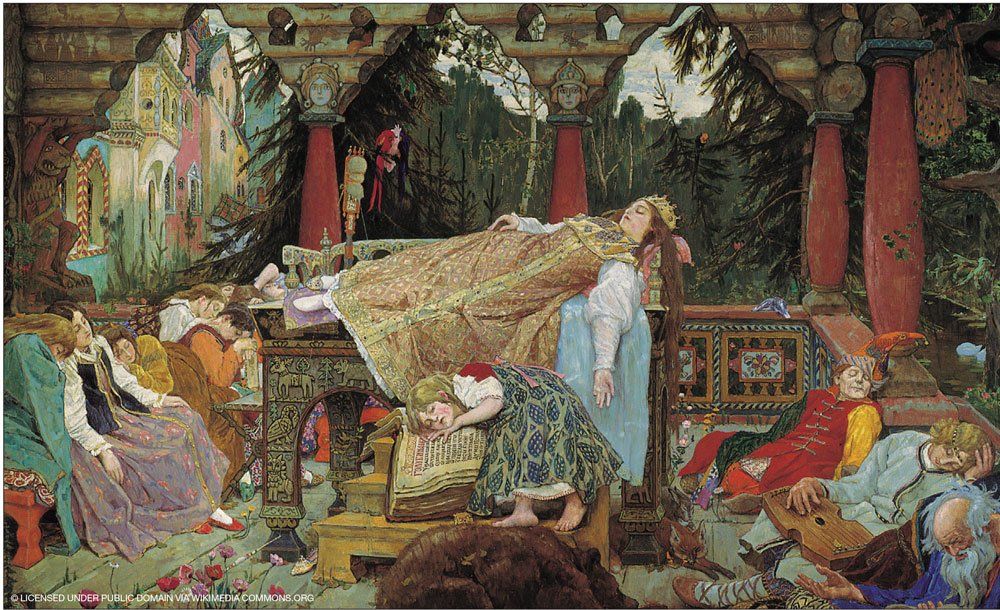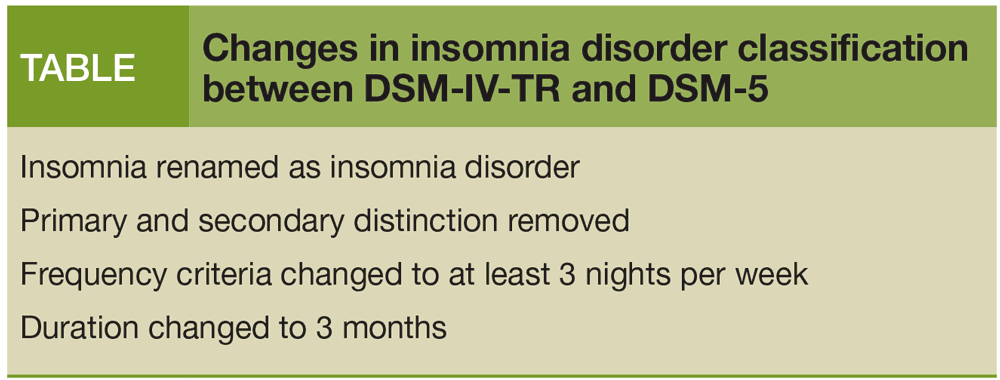Publication
Article
Psychiatric Times
A Review of Changes in DSM-5 Sleep-Wake Disorders
Author(s):
DSM-5 sleep-wake disorders are now more in sync with other medical disorders and sleep disorders classificatory systems. Here's what's changed.
Sleeping Princess: An early 20th-century painting by Victor Vasnetsov. Licensed under Public Domain via Wikimedia Commons.org

TABLE: Changes in insomnia disorder classification between DSM-IV-TR and DSM-5

Healthy sleep is required for restoring functioning and vitality, promoting memory consolidation, and maintaining immune function. However, many individuals are affected with sleep disorders. There are about 60 million Americans who have problems with sleep, with associated costs of about $16 billion each year in medical care. Insomnia affects about 10% to 15% of the population, sleep apnea affects about 10%, followed by other sleep disorders, such as restless legs syndrome and circadian rhythm disorders. Untreated sleep disorders can increase the risk of heart disease, motor vehicle accidents, memory problems, depression, and impaired functioning.1-3
The DSM-5 Sleep-Wake Disorders Work Group worked closely with other nosology systems (eg, International Classification of Sleep Disorders, third edition [ICSD-3]) to incorporate changes in diagnoses. DSM-5 sleep-wake disorders are now more in sync with other medical disorders and sleep disorders classificatory systems. In DSM-5, the pathological and etiological factors associated with sleep-wake disorders are taken into consideration, as is the increase in awareness and knowledge gained from sleep studies. The aim is to increase uniformity and consistency among health care professionals when they are assessing and treating patients with various sleep disorders. Sleep-wake disorders comprise 11 diagnostic groups:
• Insomnia disorder
• Hypersomnolence disorder
• Narcolepsy
• Obstructive sleep apnea hypopnea
• Central sleep apnea
• Sleep-related hypoventilation
• Circadian rhythm sleep-wake disorders
• Non–rapid eye movement (NREM) sleep arousal disorders
• Nightmare disorder
• Rapid eye movement (REM) sleep behavior disorder
• Restless legs syndrome and substance-/medication-induced sleep disorder
Growing evidence has shown that sleep disorders coexist with other medical and psychiatric disorders and may not be mutually exacerbating. DSM-5 underscores the need for independent clinical attention of a sleep disorder regardless of mental or other medical problems that may be present. DSM-5 also recognizes that coexisting medical conditions, mental disorders, and sleep disorders are interactive and bidirectional. Two previous diagnoses have been eliminated: sleep disorder related to another mental disorder and sleep disorder related to another medical condition.
Insomnia disorder
The most significant change in sleep-wake diagnostic criteria is in the insomnia classification (Table). The DSM-IV distinction into primary and secondary insomnia is removed in DSM-5. This stresses the comorbid nature of insomnia and calls for treatment of both insomnia and the medical disorder. This change in insomnia diagnostic criteria in ICSD-3 and DSM-5 implies a paradigm shift.
Insomnia is insomnia is insomnia, according to Michael Sateia,4editor of ICSD-3. Insomnia is a disorder in itself that needs independent clinical attention. The diagnostic criteria have been made more specific by putting in frequency criteria; in addition, the duration has been changed to 3 months. DSM-5 and ICSD-3 insomnia diagnostic criteria are similar because of collaborative efforts between the American Psychiatric Association and the American Association of Sleep Medicine classification task forces. The changes in insomnia diagnostic criteria give it more specificity and ensure greater uniformity. According to Charles Reynolds III, MD, chair of the DSM-5 Sleep-Wake Disorders Work Group, “To achieve optimal treatment outcomes in people with both a psychiatric disorder and insomnia, the clinician needs to target both disorders.”5
CASE VIGNETTE
Mr S, a 53-year-old man, is referred to a sleep disorders clinic for evaluation of insomnia and daytime somnolence. He has been struggling with depression and anxiety, for which he is being treated.
Mr S reports that he has had insomnia for many years and that it had gotten worse in the past 10 years. He has trouble with sleep initiation-it often takes him more than an hour to get to sleep. Once he is asleep, he wakes up multiple times then struggles to get back to sleep. He tosses and turns in bed until morning and gets up feeling tired and exhausted.
His primary care physician prescribed zolpidem, but this caused sleepwalking episodes, so Mr S discontinued it. Mirtazapine was tried, but it caused weight gain and was also discontinued. He takes trazodone for insomnia and fluoxetine for depression. This combination has been helpful, but he still has persistent symptoms of insomnia and depression. His wife reports that he snores and there have been occasions when he stopped breathing while sleeping. He has comorbid type 2 diabetes mellitus, hypertension, and gastroesophageal reflux disease.
The primary diagnosis is DSM-5 insomnia disorder. Given the comorbid symptoms of depression and obstructive sleep apnea, it would be difficult to evaluate whether Mr S has DSM-IV primary insomnia; DSM-5 allows the clinician to make a causal attribution between insomnia and comorbid depression and obstructive sleep disorder.
Comorbid obstructive sleep apnea is diagnosed on the basis of clinical and polysomnographic evaluations. Mr S is treated with continuous positive airway pressure. He reports improvement in his energy level during daytime, but he continues to struggle with insomnia. His nighttime awakenings decreased to 2 or 3 times and nocturia is diminished as well. Despite these improvements, he still struggles with insomnia. An increase in the dose of trazodone by 75 mg and initiation of cognitive-behavioral therapy for insomnia (CBT-I) helped him significantly. Mr S is sleeping bet- ter and continues CBT-I; treatment with trazodone continues, with a slow and gradual taper.
Hypersomnolence disorder
The distinction of primary hypersomnia has been eliminated and replaced with hypersomnolence disorder. The added criterion of coexisting mental and medical disorders that do not adequately explain the predominant complaint of hypersomnolence emphasizes the need for independent clinical relevance and attention to the disorder. In addition, there are duration criteria-acute (less than 1 month), subacute (1 to 3 months), and chronic (longer than 3 months)-and there is the dimensional approach of specifying the severity of the disorder as mild, moderate, or severe.
Narcolepsy
DSM-5 incorporates current advancements in our understanding of narcolepsy by incorporating hypocretin deficiency into its diagnostic criteria. The criteria of irrepressible sleepiness occurrence is now at least 3 times per week over the past 3 months (previously specified as daily). Polysomnographic and multiple sleep latency findings are also incorporated into the diagnostic criteria, which gives the diagnosis more specificity and uniformity and makes it more objective.
There are now 5 subtypes of narcolepsy with mild, moderate, or severe specificity:
• Narcolepsy without cataplexy but with hypocretin deficiency
• Narcolepsy with cataplexy but without hypocretin deficiency
• Autosomal dominant cerebellar ataxia, deafness, and narcolepsy
• Autosomal dominant narcolepsy, obesity, and type 2 diabetes mellitus
• Narcolepsy secondary to another medical disorder
Breathing-related sleep disorders
In DSM-5, breathing-related sleep disorders are divided into 3 relatively distinct disorders:
• Obstructive sleep apnea hypopnea
• Central sleep apnea
• Sleep-related hypoventilation
This change uses the pathophysiologic basis of these disorders. DSM-5 includes diagnoses of obstructive sleep apnea on polysomnography alone when there are more than 15 respiratory events an hour, regardless of symptoms. This criterion highlights the importance of diagnosing and treating obstructive sleep apnea, which is believed to cause and worsen medical disorders such as hypertension, diabetes, obesity, coronary artery disease, congestive heart failure, cardiac arrhythmias, substance use, and anxiety.
Circadian rhythm sleep-wake disorders
The subtypes of circadian rhythm sleep-wake disorders have been changed and expanded to include advanced sleep-phase type, irregular sleep-wake type, and non–24-hour sleep-wake type. The jet lag type has been removed. Delayed sleep-phase type is now sub-specified into familial type and overlaps with non– 24-hour sleep-wake type. And, it incorporates familial sub-specification of advanced sleep-phase type disorder. Circadian rhythm sleep-wake disorders are sub-specified into episodic, persistent, or recurrent.
Parasomnias
Parasomnias are disorders characterized by abnormal behavioral, experiential, or physiological events that occur during sleep, specific sleep stages, or sleep-wake transitions. DSM-5 divides NREM sleep arousal disorders into sleepwalking type and sleep terror type. It further sub-specifies sleepwalking type with sleep-related eating or sleep-related sexual behavior (sexsomnia).
The criteria for nightmare disorder includes coexisting mental and medical disorders that do not adequately explain the predominant complaint of dysphoric dreams. The specificity criteria include duration and severity indicators.
DSM-5 gives specific diagnostic criteria for REM sleep behavior disorder as a parasomnia category of its own rather than including it as a subtype of parasomnia not otherwise specified (NOS) as in DSM-IV. Parasomnia NOS has been removed in DSM-5.
Restless legs syndrome
Restless legs syndrome is elevated to its own diagnostic and independent category to incorporate the frequency and duration of symptoms and specific symptom criteria. This is more in line with the ICSD classification of restless legs syndrome.
Substance-/medication- induced sleep disorder
DSM-5 broadens substance-induced sleep disorder of DSM-IV to incorporate medication-induced sleep disorder. It has been evident from clinical experience and literature that many medications, particularly psychotropic medications, can cause or exacerbate sleep problems and disorders. Adding this category broadens clinical acumen and calls for clinicians to evaluate for possible medication-related effects.
Conclusions
Evaluation and treatment of sleep disorders are of paramount importance in health promotion and prevention of disease, morbidity, and mortality. DSM-5 strives to bring uniformity and more precision in diagnoses of sleep disorders-sleep-wake disorders are now more in sync with other medical disorders and sleep disorders classificatory systems. DSM-5 stresses the need for independent clinical attention to sleep disorders regardless of psychiatric or other medical problems that may be present.
The changes in DSM-5 will hopefully lead to better uniformity and precision in diagnoses and consequently better clinical attention to and treatment of sleep disorders. The changes in the diagnostic criteria for insomnia disorder are particularly important and will have significant implications in diagnoses, treatment, and research.
Disclosures:
Dr Khurshid is Clinical Associate Professor and Chief of the Neuromodulation and Sleep Disorders Program in the department of psychiatry at the University of Florida College of Medicine in Gainesville. He reports no conflicts of interest concerning the subject matter of this article.
References:
1. Ohayon MM. Prevalence and comorbidity of sleep disorders in general population [in French]. Rev Prat. 2007;57:1521-1528.
2. Daley M, Morin CM, LeBlanc M, et al. The economic burden of insomnia: direct and indirect costs for individuals with insomnia syndrome, insomnia symptoms, and good sleepers. Sleep. 2009;32: 55-64.
3. Chung WS, Lin CL, Chen YF, et al. Sleep disorders and increased risk of subsequent acute coronary syndrome in individuals without sleep apnea: a nationwide population-based cohort study. Sleep. 2013;36:1963-1968.
4. Sateia MJ. International Classification of Sleep Disorders-third edition: highlights and modifications. Chest. 2014;146:1387-1394.
5. Lamberg L. Manual updates sleep disorders diagnoses. Psychiatr News. August 14, 2014. http://psychnews.psychiatryonline.org/doi/full/10.1176/appi.pn.2014.8b20. Accessed July 20, 2015.





